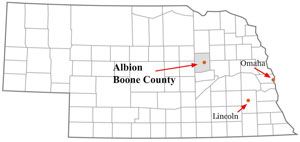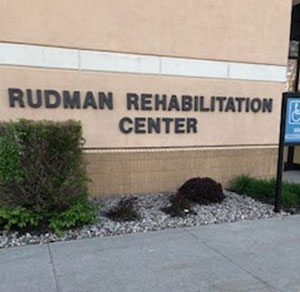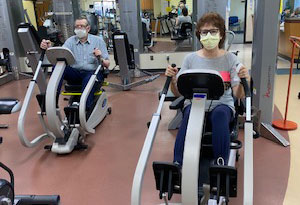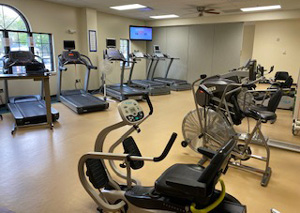Boone County Health Center Pulmonary Rehabilitation Program
- Need: Evidenced-based intervention to improve function and quality of life for patients with chronic obstructive pulmonary disease and other chronic lower respiratory conditions.
- Intervention: Pulmonary rehabilitation program implementation in 1989.
- Results: Compared to a national average of only about 3% of referred Medicare beneficiaries actually enrolling in pulmonary rehabilitation, 60% of the program's referred patients enroll. Averaging around 15 patients/year completing the program, a large combined cardiac and pulmonary rehabilitation maintenance population averages 8,000 visits/year.
Description
Cardiovascular and lower respiratory conditions are leading causes of death in rural America. For Nebraskans with chronic obstructive pulmonary disease (COPD), a 2011 Centers for Disease Control and Prevention survey revealed that nearly 60% of the state's respondents with COPD reported having their activity limited by the condition and about 20% reported experiencing poor mental health for more than 2 weeks of each month. A long-standing known treatment beneficial for these condition-related issues is pulmonary rehabilitation, referred to as PR.
 Boone County Health
Center (BCHC), Albion, Nebraska, has offered PR to
the people in its service area with chronic obstructive
pulmonary disease (COPD) and other respiratory conditions
for over 30 years. The program began in 1986 when a
member of the hospital's nursing staff observed a
tertiary care center's cardiac rehabilitation (CR)
program. Despite the center's concern that CR could not
be delivered in a rural Critical Access Hospital (CAH),
CR was started in 1987 eliminating patients' 270 mile
round-trip travel burden. Immediate success of the CR
program led to the addition of pulmonary rehabilitation
(PR) in 1989.
Boone County Health
Center (BCHC), Albion, Nebraska, has offered PR to
the people in its service area with chronic obstructive
pulmonary disease (COPD) and other respiratory conditions
for over 30 years. The program began in 1986 when a
member of the hospital's nursing staff observed a
tertiary care center's cardiac rehabilitation (CR)
program. Despite the center's concern that CR could not
be delivered in a rural Critical Access Hospital (CAH),
CR was started in 1987 eliminating patients' 270 mile
round-trip travel burden. Immediate success of the CR
program led to the addition of pulmonary rehabilitation
(PR) in 1989.
 The hospital
has about a 50-mile service radius and serves as a hub
for 4 rural health clinics (RHCs) located about 25 miles
in all directions from BCHC. Care is delivered by 8
physicians and 8 advanced practice providers. As
suggested by a 2019 academic
review on PR services in rural hospitals, the BCHC
website lists PR program under its services. Providers
order PR using order sets available in the clinic- and
hospital-based electric health record (EHR).
The hospital
has about a 50-mile service radius and serves as a hub
for 4 rural health clinics (RHCs) located about 25 miles
in all directions from BCHC. Care is delivered by 8
physicians and 8 advanced practice providers. As
suggested by a 2019 academic
review on PR services in rural hospitals, the BCHC
website lists PR program under its services. Providers
order PR using order sets available in the clinic- and
hospital-based electric health record (EHR).
 The program is located on
the hospital campus in a dedicated 4,000 square foot
rehabilitation center, built as a result of a private
donation. The space also houses cardiac rehabilitation
and physical and occupational therapy services. Medical
directorship and supervising provider — the latter as the
mandatory on-site provider for the program — roles are
filled by the local primary care physicians.
The program is located on
the hospital campus in a dedicated 4,000 square foot
rehabilitation center, built as a result of a private
donation. The space also houses cardiac rehabilitation
and physical and occupational therapy services. Medical
directorship and supervising provider — the latter as the
mandatory on-site provider for the program — roles are
filled by the local primary care physicians.
Services offered
Program requirements:
- Participants must meet GOLD criteria guidelines: moderate, severe, or very severe COPD as determined by spirometry performed either at BCHC the hospital or at the visiting pulmonologist office, who travels from another Nebraska community, a round trip distance of nearly 200 miles.
PR program services follow current Centers for Medicare and Medicaid Services (CMS) statuary requirements and include these specific elements:

- Individualized treatment plan
- Goal setting
- Education
- Exercise component
- Breathing techniques
- Nutrition, psychosocial needs
- Medication adherence
- Oxygen use and needs
- Balance training
- Address other core components: diabetes, tobacco use, weight management, etc.
Equipment:
- Exercise equipment: Treadmills, stationary bicycle, recumbent stepper, ellipticals, Arc trainer recumbent bicycle, weight machines
- Oxygen
- Cardiopulmonary resuscitation equipment, including defibrillator
Dedicated staff:
- Exercise physiologist
- Registered nurses
- Community health coordinator
- Receptionist
Hospital-based staff available to PR patients as needed:
- Dietitian
- Social worker
- Pharmacist
- Mental health staff
- Respiratory therapist
- Physicians serving and medical directors and direct supervisors
Anticipated new prevention and education services:
Education is integral to PR and the BCHC PR staff recognizes the value of prevention education in preventing worsening of any chronic lower respiratory conditions. Smoking cessation is included, but 25% of COPD patients have not smoked and experts point to other risk factors present in rural areas, such as dust, mold, and chemical exposure as contributing to worsening chronic lung conditions as well as causing them. Since a high percentage of the people in the BCHC service area have a generational involvement in agribusiness, the organization is developing an education program for proper respiratory personal protective equipment.
Results
 Though the total number of area's
eligible patients can't be assessed, the total number of
identified patients can, as well as the number of
patients that are referred and actually enroll: 95% of
those identified are referred and 60% of patients
referred actually enroll.
Though the total number of area's
eligible patients can't be assessed, the total number of
identified patients can, as well as the number of
patients that are referred and actually enroll: 95% of
those identified are referred and 60% of patients
referred actually enroll.
- Note: These results can be compared to national data showing nearly 70% of primary care physicians were aware of PR availability, yet only about 40% routinely prescribed PR and that of Medicare beneficiaries referred to PR, only about 3% enroll.
About 15 patients per year complete the PR program and average about 30% of the total new patient load of cardiac and pulmonary rehabilitation. The program completion rate is high with graduates joining the large maintenance population that averages 8,000 visits/year.
Challenges
- Accommodating the busy schedules of farmers and ranchers in the hospital's service area population.
- Early identification of patients with lung disease.
- Acceptance that PR is:
- More than exercise
- the use of modern equipment and evidence-based program elements that have proven benefits in lung disease
Replication
- It's important to start new programs with the premise that pulmonary rehab is not a "faux" cardiac rehabilitation program.
- Pulmonary patients are unique and have their own set of physical and behavioral health problems which requires individualization of the participant's program.
- Focus on provider education using supporting data on the benefits of PR on quality of life and longevity.
- Be prepared for increased time needs of the PR patient since they require breathing coaching and recovery rest periods.
Contact Information
Gayla Oakley RN, CCRP, MAACVPR, Director of Cardiology Services and PreventionBoone County Health Center
402.395.3149
goakley@boonecohealth.org
Topics
Access
· Agricultural health and safety
· Cardiovascular disease
· Chronic disease management
· Chronic respiratory conditions
· Critical Access Hospitals
· Health disparities
States served
Nebraska
Date added
June 10, 2021
Suggested citation: Rural Health Information Hub, 2022 . Boone County Health Center Pulmonary Rehabilitation Program [online]. Rural Health Information Hub. Available at: https://www.ruralhealthinfo.org/project-examples/1091 [Accessed 28 December 2025]
Please contact the models and innovations contact directly for the most complete and current information about this program. Summaries of models and innovations are provided by RHIhub for your convenience. The programs described are not endorsed by RHIhub or by the Federal Office of Rural Health Policy. Each rural community should consider whether a particular project or approach is a good match for their community’s needs and capacity. While it is sometimes possible to adapt program components to match your resources, keep in mind that changes to the program design may impact results.
